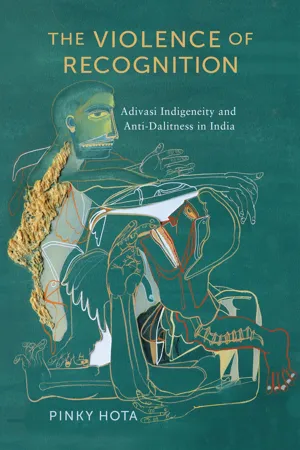
- 232 pages
- English
- ePUB (mobile friendly)
- Available on iOS & Android
About This Book
The Violence of Recognition offers an unprecedented firsthand account of the operations of Hindu nationalists and their role in sparking the largest incident of anti-Christian violence in India's history. Through vivid ethnographic storytelling, Pinky Hota explores the roots of ethnonationalist conflict between two historically marginalized groups—the Kandha, who are Adivasi (tribal people considered indigenous in India), and the Pana, a community of Christian Dalits (previously referred to as "untouchables"). Hota documents how Hindutva mobilization led to large-scale violence, culminating in attacks against many thousands of Pana Dalits in the district of Kandhamal in 2008.Bringing indigenous studies as well as race and ethnic studies into conversation with Dalit studies, Hota shows that, despite attempts to frame these ethnonationalist tensions as an indigenous population's resistance against disenfranchisement, Kandha hostility against the Pana must be understood as anti-Christian, anti-Dalit violence animated by racial capitalism. Hota's analysis of caste in relation to race and religion details how Hindu nationalists exploit the singular and exclusionary legal recognition of Adivasis and the putatively liberatory, anti-capitalist discourse of indigeneity in order to justify continued oppression of Dalits—particularly those such as the Pana. Because the Pana lost their legal protection as recognized minorities (Scheduled Caste) upon conversion to Christianity, they struggle for recognition within the Indian state's classificatory scheme. Within the framework of recognition, Hota shows, indigeneity works as a political technology that reproduces the political, economic, and cultural exclusion of landless marginalized groups such as Dalits. The Violence of Recognition reveals the violent implications of minority recognition in creating and maintaining hierarchies of racial capitalism.
Frequently asked questions
Information
Table of contents
- Cover
- Half Title
- Series Page
- Title Page
- Copyright
- Dedication
- Contents
- Introduction
- Chapter 1. Crafting Indigeneity and Its Other
- Chapter 2. Recognition Without Redistribution
- Chapter 3. Duplicitous Dalits
- Chapter 4. Adivasi as Hindu
- Chapter 5. Sacred Land, Sacred Nation
- Chapter 6. Carnality of Capital
- Conclusion
- Notes
- Bibliography
- Index
- Acknowledgments